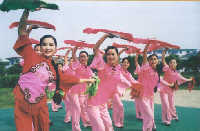 Dubbed the "Ballet of the East", the "Flower-drum Lantern" is the most representative folk dance in East China'sAnhui Province. The folk art has a solid foundation among audiences of the famous historical city ofShouxianand is imbued with a rich countryside flavor of theHuaihe RiverValley.Having originated in the Huaihe River Valley and having thrived in more than 20 nearby counties, the "Flower-drum Lantern" is the richest and most complete folk dance, having staged the greatest number of performances in Anhui Province.
Dubbed the "Ballet of the East", the "Flower-drum Lantern" is the most representative folk dance in East China'sAnhui Province. The folk art has a solid foundation among audiences of the famous historical city ofShouxianand is imbued with a rich countryside flavor of theHuaihe RiverValley.Having originated in the Huaihe River Valley and having thrived in more than 20 nearby counties, the "Flower-drum Lantern" is the richest and most complete folk dance, having staged the greatest number of performances in Anhui Province.
The "Flower-drum Lantern," which emerged in theMing Dynasty(1368-1644) and became popular in the lateQing Dynasty(1644-1911) and the early period ofthe Republic of China(1912-1949), is a song-and-dance folk art with very demanding dance skills. In Fengtai and Huaiyuan along the Huaihe River, the "Flower-drum Lantern" has the most distinctive features due to the river's particular geographical situation. Since the Huaihe River is located to the south of theYellow Riverand north of theYangtze River, performances here are tinged with a touch of the boldness of the northern people, as well as the gentleness typical of people in southern China.
The "Flower-drum Lantern" contains wide and profound social implications, and is a rich and varied song and dance art which, with all its armor, boldness, humor and wit, embodies the straightforwardness and optimism of people living along the Huaihe River. The "Flower-drum Lantern" has appeared at many grand domestic celebratory activities and has been granted various honors on several occasions. Late premier Zhou Enlai once praised it as the "Oriental Ballet". Literary and art circles deem the dance as "a national treasure of folk dances", and "a typical representative of Han dances".
 Characteristics of the 'Flower-drum Lantern'
Characteristics of the 'Flower-drum Lantern'
As a large-scale song-and-dance performance, the "Flower-drum Lantern" integrates both dance and song, including musical performances by gongs and drums, and a small-scale opera programme. Solo dances, duet dances, trio dances and group dances can all be found in the "Flower-drum Lantern" performances, and its movements are mostly refined from the labor process and daily life. Songs from the "Flower-drum Lantern" are called "Flower-drum Songs" and come from the folk tunes of the banks of the Huaihe River. The tunes are especially capable inexpressing emotions -- either lively and beautiful, or aggrieved and depressed. Accompanyingmusical instrumentsinclude a big gong, cymbals, aflower drumand a small gong; main props for performances include a forkumbrella, folding fan, handkerchief and arm drum.
